#glue binding technology
Explore tagged Tumblr posts
Text

Glue Binding Technology in Perfect Binding Machines
Discover the power of glue binding technology in perfect binding machines and how it ensures durable, professional-quality bookbinding. Learn about the different adhesives used, including EVA, PUR, and hot melt glue, along with the step-by-step process of perfect binding. Explore the advantages, applications, and key factors to consider when choosing a perfect binding machine for your printing needs. Whether you're in commercial printing or self-publishing, this guide covers everything you need to know about glue binding technology. Looking for high-quality binding solutions? Electro Mec offers top-tier perfect binding machines to enhance your production efficiency.
#binding machine#perfect binding#book binding machine#post printing machine#book binding#post printing#glue binding technology
0 notes
Text
Coming Home (But Not to You) + Someplace New Physical Bind



i've done a few rebinds of paperbacks to hardcovers but this is my first ever full bind :')
i really love this universe written by @lesbianherald and i'm so delighted to have a forever copy! i keep coming back to it, so having it on paper will make it much easier to tab out my favourite parts when i need them.
there's definitely mistakes, especially with the cover (pls don't ask about the back cover it's none of my business). i hit a point where i chose done over good because otherwise this would have taken me 6 months. there is no prize to perfection etc.
Coming Home clocks in at around 360 pages and Someplace New is about 60. i included the playlists for both since i'm a sucker for 'bonus content'. in paper, that means 107 sheets of a4 split into 14 signatures of 7-8 pages.
some retrospectives and the guides i followed below:
what went well:
the actual process of folding signatures and sewing the binding was my favourite part. basically all the work that didn't involve fighting technology lmao
i struggled sourcing a4 short grain but i'm really happy i used it! it's such a floppy, soft book and it sits open on it's own
i hated the cover design in canva but on the book it looks sick as hell. very trust the process kind of deal
what didn't go well:
i'll never learn my lesson about text and heat transfer vinyl. this is where i almost lost my mind
speaking of htv, i really screwed up every step of the case creation. my boards are a little short, i wasted a load of book cloth, and i used to much glue for the endpapers that it seeped through a little. not enough to do major damage to the textblock, but the first and last 20 pages are a little wavy
Resources:
How To Typeset in Google Docs - i followed about 3 different tutorials for doing it in word before finding this video. very easy to follow and she shows how to impose to signatures afterwards
How To Bind on a Budget (Beginner Friendly)
French Link Stitch Bookbinding tutorial
268 notes
·
View notes
Text
Ethan Hunt and the worst team composition (barring that time one of this team mates literally was a traitor)
one idea that solidified on this rewatch is we all know the Big Joke/Theme of GP is that all the tech fails, because Brad Bird hates technology. nearly every single failure in the movie is due to the tech failing.
HELL, THE LAST IMF CACHE IN THE WORLD THAT THE SECRETARY LEFT FOR ETHAN IS IN A MOVING TRAIN CAR. TO GET IN, YOU NEED TO COMPLETE A RETINAL SCAN. THE SCANNER IS TOO HIGH OFF THE GROUND FOR ETHAN HUNT.
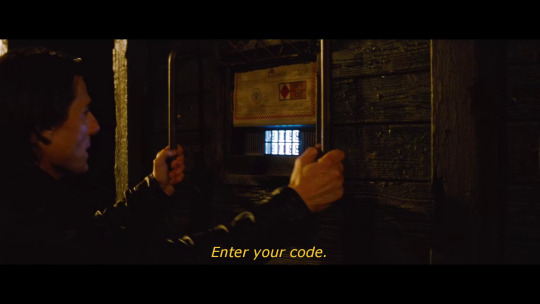
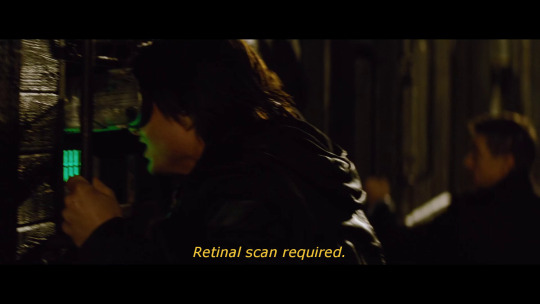
Ethan having to grab the bars and physically lift himself fully off the ground to jam his face into the stupid fucking scanner while he and Brandt race to keep up with the train is still the second-funniest moment in the franchise.
Anyway my actual point is what solidified on this watch was that the team was also a fucking mess. As a movie you are watching, the chemistry of the team is what makes this movie work. The energy of Jane, Brandt, and Benji is the soul of the movie and when the franchise (i.e. McQuarrie) realizes these movies are about the ensemble.
But in-universe, the watsonian read? Is Ethan is hamstringed as much by team composition as much as the tech.
Like, weird example, but in Ted Lasso season 3, Jamie's character arc in part is about how he becomes the conductor of the team. His position is to be the adhesive glue that binds all the players together and he's the one to direct the momentum of play. Everyone on the field is forced to react to him specifically.
Ethan is the same, his power is in conducting people and getting the team working. Except he has to manage:
Brandt, an analyst who spends most of the mission prep looking wet and sad in the corner
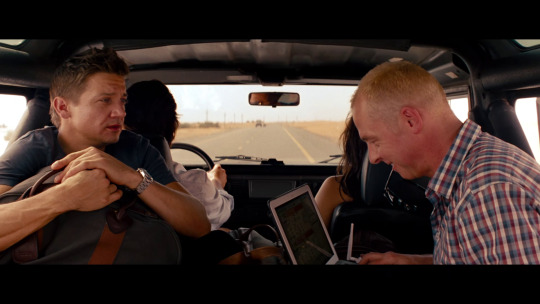
or being the No, But guy to every plan, and who can be phenomenal pain in Ethan's ass. He actively contributes more stress to the mission at all points and Ethan has to directly talk him down from throwing the entire plan literally out of the window.

Just Brandt would be hard enough to manage but SPEAKING OF THROWING PLANS OUT THE WINDOW.
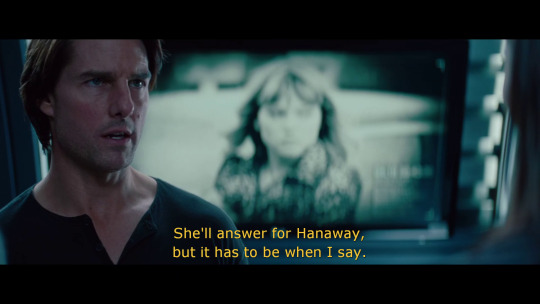

Jane is a lit fuse who is going to fuck up the mission and Ethan knows it from the start. The moment it's clear they need Moreau, the woman who killed Jane's lover
(AND AGAIN I TALKED ABOUT THIS BEFORE BUT I STILL LOVE HOW JANE CARTER GETS THE MANPAIN-IEST STORY EVERY, I love GP.)
the moment that's clear, Jane is a problem Ethan also has to manage. She's competent and she's the most on-board with the plan because she's a seasoned field agent, but she is still someone he cannot trust to keep her head.
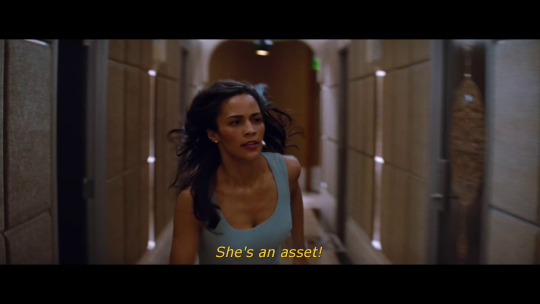
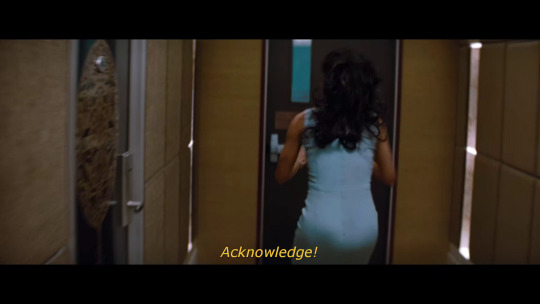


And the EXACT thing Ethan's worried about happens. In the heat of the moment, Jane insists on going after Moreau and while she makes a game attempt to not kill her.... she still very much kicked her out the fucking window. That is a thing that Ethan saw coming and it did happen.



I fucking die every time Jane and Brandt start having a screaming match while Ethan is in the bathroom like "send me back to prison. I was enjoying prison. I had my rock. I had a friend who didn't give me agida. Fuck my life."
And I SWEAR TO GD this is not just me being a Benji Stan but Benji is green and annoying, but also look at this sequence here real quick:
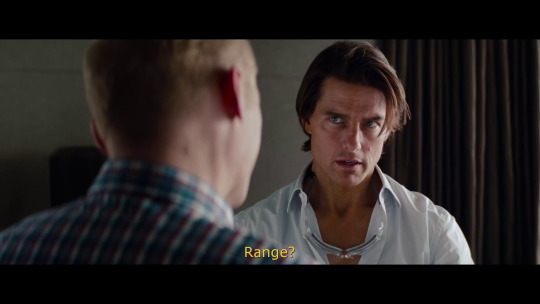

Ethan: Masks? Benji: Sixty seconds. You sure I should wear a mask? You know, 'cause I'm not exactly Omar Sharif-- (sees Ethan's look) I'll play it French. This is your tracking device. This is what you're tracking. Ethan: The paperclip? Benji: No, it's the paper. It's in the briefcase. It's coated with isotopes which give off a unique-- (REALIZES THIS IS UNIMPORTANT RIGHT NOW) -- It just means that you can track the documents even if they switch briefcases. Ethan: Range? Benji: Not that good, it's like half a mile.
Benji is a newbie and green as hell, but he gets to the point and he gives Ethan the exact information he needs and reacts better and better as things get more stressful. He needs the least management and oversight by far.


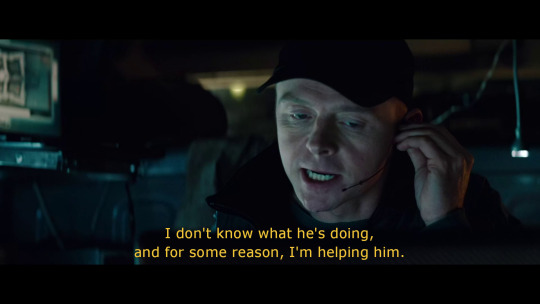
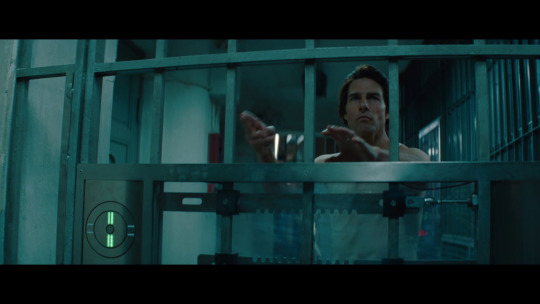
Which is also set up in Ethan's intro, at the prison. Even though Ethan is probably unsure who the field technician is, he immediately gets them to say "Yes, And" and assist him. I love the physicality of Ethan blowing a 'thank you' kiss to the camera and then signalling 'keep your eyes on me' and then just signaling what he needs as he races down the cell block. And it works!
Before he even knows it's Benji, the same tech he got to Yes, And him in a crisis in MI3, he knows he can work in tandem. If he can temper Benji's moments of just not being used to field work, Benji is a hands-off asset to the team. Which Ethan fucking needs while he's trying to manage Jane and Brandt.
Is it a coincidence that Ethan finally emerges from his sulk in the bathroom when Jane and Brandt begin to turn their anger on Benji, physically redirecting the rooms attention to him? Probably but it's interesting nonetheless.
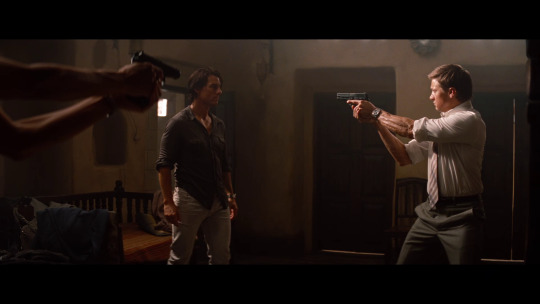

(I've stated this in fic before but I think Ethan lowkey hates working with Brandt. Not that he dislikes Brandt at all as a person, just that he requires so much extra management and bandwidth. And my watsonian reason for Jane not being on Ethan's team again is "You're a great agent, I respect you, pls go lead another team, I do not want to manage you again, kthxbai." WHICH IS SUPPORTED BY THE PARALLELING EXPLICITLY DRAWN BETWEEN THEM:
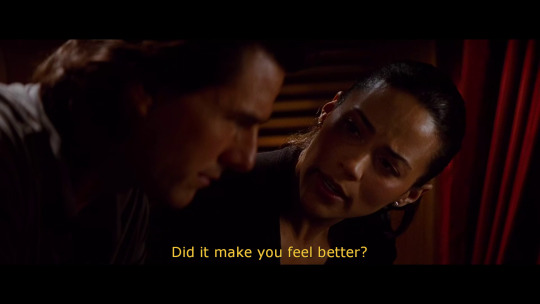

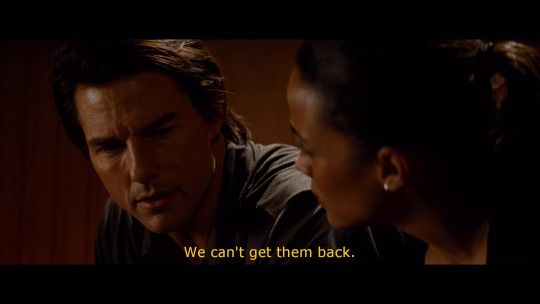
gddamn i love the Jane Carter Manpain Arc so much.)
My point is: Ghost Protocol is funny and colorful and entertaining as hell, and it works because the four leads have mad-on chemistry, but in-universe this team composition is Ethan's personal fucking nightmare and he should have just stayed in prison. HELL, THIS IS THE MOVIE WHERE ETHAN FULLY TRIES TO ABANDON HIS TEAM BC THEY SUCK SO MUCH. And circumstances force him to finish the job with them, BUT HE DOES TRY TO LEAVE THEIR ASSES.
Anyway, if you read the dossiers of the Big Four (Luther, Ilsa, Ethan, Benji) that were mocked up for Fallout but are used in Dead Reckoning, Benji and Ethan's dossiers make it clear that after this point, Ethan refuses to work with non-Benji field techs and basically monopolizes Agent Dunn for the next 15-ish years.
GREAT MOVIE. If you are gonna start watching Mission Impossible, start with Ghost Protocol.
ETA: actually that bit I started with "barring that one time one of his team was literally a traitor"? I take that back. Because in MI1, yes, Krieger is fully a traitor who tries to kill Ethan, but he's easy for Ethan to manage. Ethan literally just pisses him off enough to make him storm off. That dude is EASY next to Jane and Brandt. L M A O.
82 notes
·
View notes
Note
*grabs ForestClan mod like the cat that knocked over the onions in the meme* YOU. The muse has infected me! I caught myself making up poems and rhymes, trying to make them ForestClan style, for trying to teach the clans things like pottery and making alcohol! Alcohol disinfects, and feeds flames really well, after all! XP
That said, where do you see the clan's current technology level? We know they can make jerky, and some form of rope, as well as keeping a fire. What else can the clan make, do you think? :3
LOL Hey listen I’ll take the compliment!! Nursery rhymes and repetitive songs are how we teach kids about basic things like the alphabet, parts of our bodies and fairytales, so why not medicine and other core practices for Warriors, right?
Most of ForestClan’s technology use is very similar to how @rippleclan has written theirs! We were both heavily inspired by @bonefall ‘s Better Bones AU, and their descriptions of weaving, cooking, even baking and creating things like terracotta, vinegar, and using medicinal leeches! I am still making up ForestClan’s technology use as I write - mainly because Bonefall pulls all their tech ideas from resources available in Europe/Britian where the OG Warriors series locations are inspired by, but ForestClan is located somewhere around the Great Lakes/Appalachian Trail, where the climate and materials available are different. Their available tech use is often made up on the spot, for me, where I want to write something and then I look around to see if such a thing is feasable!
Things I know for sure ForestClan can do right now technologically, other than what you’ve listed:
- Basic pulley systems using logs and rope (for their sliding gate)
- Weave baskets
- Skin pelts and make tanning racks
- Use sap as glue/binding agent
- I’m STRONGLY considering them knowing how to tap maple trees for syrup because I mean if I’m around the Great Lakes???
- Make clay/stone bowls to boil water in, allowing for soups, stews, and teas, and clean drinking water
- Sharpen sticks or logs to erect on their walls for defense
- IN THE WINTER, they can dig tunnels and mold snow around the outside of their dens to better insulate them, kind of like how an igloo can insulate heat
- Medicine use capabilities are greatly expanded, such as certain herbs capable of changing hormones and a cat’s scent (gender affirming care), and minor surgeries. ForestClan USED to be able to do pretty major surgeries, but the precision, careful tools and quick work required to do them became lost with Chicoryglint’s absence. Windfur never got the chance to truly absorb that knowledge confidently.
ForestClan’s technology use is pretty high, I’d say, but still primitive. Despite Shiverpaw being able to hear Rootgrove through the radio, ForestClan is not about to figure out analog technology anytime soon LOL.
18 notes
·
View notes
Text
the importance of social technology in social change
TLDR: By retooling, devouring, and innovating our social technologies, we can create participatory organizations that enable egalitarian social change. These organizations should be animated by an understanding of hierarchy, its relation to oppression writ-large, and how to create and employ social technologies that distribute power, rather than concentrating it.
Introduction
We take technology for granted in general (most people I know don’t think much about how water gets to their sink unless it doesn’t work, for example), but this seems especially true for our social technologies. We take things like democracy, laws, and even the nuclear family form at face value and as fundamental parts of reality.
So, what is technology, and how does it relate to our pending conversation? What is the throughline between obvious technologies like a stone axe and my iPhone, and more nebulous ones, like speech and the nuclear family? Any technology you can imagine takes concepts and knowledge and creates a method of applying them to specific goals, objectives, or functions. This doesn’t preclude emergent uses for tools, as you can probably think of using tools in unintended ways. This definition is useful to keep in mind as we realize that the technologies at present, animating the status quo are inadequate. We need something different to make radical, roots-grasping change.
And, for the sake of change, we need a specific way to achieve it. Part of this is technological; we need to figure out models of relating and working with one another that prefigure the changes that we want to see. To create and modify those technologies, we need to figure out which concepts and knowledge we will use.
Prefiguration can be described as “creating the new world in the shell of the old”. It’s doing things in the present that we think will get us to our imagined future. This implies the need to have a coherent conception of what is currently happening, and change will look like.
Currently, we live in a hierarchical, bureaucratic hell. This might best be epitomized by trying to obtain official identification recognized by our respective state. From all of the forms that you fill out, to the additional paperwork needed, to the horrible experience of getting that information approved, there are a lot of issues that this creates, from an experiential standpoint. One of the more under-realized aspects of issues such as this is how these experiences alienate us from the ability to do things for ourselves. Bureaucracy is a way to manage hierarchy’s inherent simplification of reality. A king couldn’t actually run their kingdom themselves, so they create layers of functionaries, under their control, to (try and) manage that complexity.
Along with my opposition, I’d like to propose something. A theory of change, that allows us to do that prefiguration work, leaving behind some of the negative methods of relating as currently mediated and handled. Since we live in a very hierarchical and bureaucratic world-system, constituting a colonial-imperialist, cisheteropatriarchical, ableist hegemony, if we create non-hierarchical/heterarchical organizational forms that allow us to relate in alignment with our values, then we will achieve a more egalitarian world, because of these organizational forms addressing fundamental contradictions in the way that society, from the personal to the global scale, is administered and ordered at present.
Having non-hierarchical organizational forms will allow us to become self-managed and autonomous, gaining collective control over collective issues, and individual control over individual issues. What is hierarchy, though? For our purposes, hierarchy can be seen as the glue that brings oppression together. It binds structures of domination, coercion, and power (specifically power-over) into oppression writ-large. This is what makes the act of arranging organizational forms a pyramid, where value, authority, and decision-making ability are concentrated toward the top. It is not a problem if some friendly games and competitions employ hierarchy in the broadest sense. The issue comes where, in that game, the folks who won got to eat and the folks who lost went hungry. The power imbalance and value judgments are what make hierarchy dangerous.
Alternatively, non-hierarchical structures that prioritize non-coercive, non-domineering principles, that enable positive versions of power-to (the ability to act) and power-with (the ability to act collectively, towards collective interest) have much more liberatory potential at their foundation. That’s what we’re aiming for, social technologies that allow for horizontal relating.
The pieces of horizontal organizations
The foundation of these horizontal, heterarchical forms should be in values and principles that enable relating in that way. Some of these values might be joy, autonomy, radically informed consent, cultivating ownness-uniqueness, and solidarity. These are defined as:
Joy: This should be a group that is constantly looking critically at how we engage with productivity, work, and formality from the perspective of prefiguring spaces of fun, play, and levity -- infusing it into as much of the work as we can. If it feels like a drag, that should at the very least give us pause. While we will not be able to avoid negativity wholesale, we can be intentional about minimizing the moments where it is unnecessary.
Autonomy: Each unit of interest (teammate, team, section/wing, whole) can operate independently from other elements as it desires, without imposition.
Radically Informed Consent: All decisions that include or impact someone should be made with that person (1) in that discussion/process and (2) having as much context and information as they need to be aware of the implications of the decision being made.
Cultivating Ownness-Uniqueness: The group should allow for a cooperative orientation that is based on finding what is best for all involved as individuals, concerning the collective goals. The group should be a tool that cultivates this orientation, rather than existing for its own sake and becoming something that holds power over the people in the space.
Solidarity: People in the group should work together around common interests and affinities, made clear in the joining process, grounded in (1) centering the most marginalized in society and/or our specific context within our spaces, and (2) sharing in the responsibilities of achieving what the group sets out to do.
Having these values as described gives us a shared language from which to judge how we relate to each other using the organizational forms we will set out to describe, to make sure that it gives opportunities to widen the spaces where our organizational aims can be achieved.
The components of these forms, the building blocks that sit atop the foundation, creating the organization when assembled, are the teammate, roles & tasks, aims & domains, the team, assemblies and summits, and the areas, functions, and committees. These are defined as:
Teammate: This is the individual in the structure. A specific person, who interfaces with the other parts of the structure.
Roles and Tasks: This is how the work is distributed within an organization, in line with the foundational principles and the aims of the specific team and organization as a whole.
aims: Objectives of the unit of interest. The thing that the unit of interest is trying to accomplish.
Domains: The range of focus a specific unit of interest has within an organization. What the unit of interest is responsible for doing.
Team: A collective unit within the structure. Multiple teammates coming together.
Assemblies and Summits: Multiple teams (or delegations of teams) coming together to deliberate on mutual aims, across mutual domains.
Areas, Functions, and Committees: Ways to group teams together (or create new teams) to cover specific aims.
These allow for us to have specific modes of relating with each other around specific things that we want to accomplish, from the individual to the organization-wide scale, with the potential to connect with outside organizations.
These values and components are important to create are heterarchical organization, but it doesn’t tell us what the organization will be doing. We know that it’s meant to be aimed towards social change, but what does that actually look like? I think that there are three interrelated things that the organization should achieve for it to be successful at its overall aims. There should be robust analysis, care work, and effective, radical action. These are described as:
Care Work: Embedding the ideas of restoration, rest, healthy engagement, sustainability, and healing into the core of the organizational structure. This can be done through things like healing circles, accountability circles, meeting "non-organizational" needs that deal with the making and remaking of folks (a la childcare, food, emotional care, etc), and other methods.
Robust analysis: Creating mental models that can approach an accurate understanding of the world, along with how to be experimental and learn from those experiments (while not seeing participants as disposable, or coercing folks into things). This horizontal orientation encourages us to be able to catalyze autonomous & self-directed action, rather than make ourselves indispensable to a movement. We should use these forms to organize ourselves out of a role, in a sense, through things such as making sure other people understand how to do what we do, and not hyper-specializing.
Effective, Radical Action: The organization, through the above two functions, should be able to achieve the goals that it sets. It should be successful at the current conjuncture, and these successes should build up to the general goals of the organization. There should be a conception of strategy, campaigns, logistics/operations, and tactics.
For any of these initiatives to be successful, there needs to be a basic security culture. Pretty much any social change org that is directly effective or building towards effectiveness necessitates modes of protection for the people in the organization. We need to protect from state, corporate, and non-state reactionaries. This is worth an in-depth conversation, but basic things like not talking to those forces, being mindful of where and when certain information is shared, if at all, and screening for new members, the intensity of which is proportional to the openness of the organization, and not fedjacketing (claim that someone is the cops) people. This would be paired with collective discussion to establish those agreements, and training/collective study to inoculate folks against bad security practices.
Arranging the pieces
Now that we’ve built up the different parts of our organizations, we can describe some ways to bring them together. I propose three different organizational shapes: phantom cells, networked guerrillas, and fractal teams and working groups. These are differentiated by the ways that the teams within the org are connected and relate to one another.
Phantom cells are the most ephemeral formation that I’ll describe. These are temporary teams created with wide variations towards some goal. They don’t even have any meaningful awareness of the composition of other cells. Actions are motivated by catalyzing forces that follow a general flow of event → action → report-back → action. Something happens that motivates a cell to form and act, that cell publishes information about their action, along with instructions on how to replicate and the ideological motivation behind it, and others follow suit. This repeats and spreads out, through stigmergy. It’s like how social media trends work. All follow a similar format, evolving as they spread until they saturate a space and wane. The goal here is to combine distributed intelligence through information posting, replicability, and inspiration.
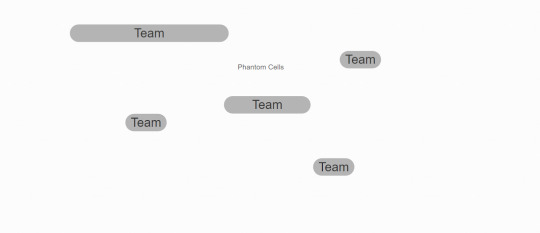
A diagram representing phantom cells. Pill shapes with the word team in the middle are spread around on a white canvas.
This form is inspired by Tiktok and the SHAC campaign. If we could have groups of folks who: (1) find concrete goals & replicable methods for finding connected goals in specific contexts, (2) create compelling narratives around acting in line with those goals, and (3) encourage easily replicable actions, consistent pressure, and sharing the results so that it spreads. This allows for action to become highly distributed, where unity isn’t based on allegiance to specific organizations, movements, or formations. This type of operation is most useful for trying to achieve protracted, quick, decisive, small actions against a target.
Networked guerrillas are cells (or teams) of folks that have a well-rounded skill set, and who work consistently together. I imagine it being like a team for an RPG (role-playing game) campaign where each character is in a different class. This group should have a relatively high amount of self-sufficiency, to be able to achieve aims within their domain without much outside assistance. Each cell is animated by a general alignment of principles, vision, and values. Cells are also designed to link up with other cells, of this type, to accomplish bigger goals and complete bigger actions. There might also be a bundle of cells “in the middle” to help coordinate resources between cells and provide additional, more specialized, and contextual resources. Ideally, there is a rotation and continual morphing of the core to not become a failure point. This is why it’s important to have the cells be as self-sufficient as possible. Every connection is an enhancement of capability, rather than a necessity. The relationships between the cells can be organized like a mesh network (many-to-many relationships between the cells), star (one-to-many-to-one relationships), and a chain/ring (one-to-one-to-one relationships), or some combination, based on the needs of the organization.

A diagram representing networked guerrillas. showing a form that combines mesh, start, and chain/ring.
Fractal teams and working groups work through a kind of fractal, heterarchical confederalism. Essentially, it flips the hierarchical nature of authoritarian federalism by having power flow from the lowest level upwards, rather than the other way around. It starts at the lowest level, the team, and we confederate upwards from there to encompass more general aims and domains, using assemblies, assemblies of assemblies, and summits. This structure also operates on the principle of autonomous collaboration, where people who are impacted by and/or are doing a specific set of tasks are the ones to decide how that task is implemented. This is meant to minimize the amount of power-over within the structure, while still fostering modes of engagement between different scales of decision making. At each level, there would be assemblies that provide the space to share information and discuss plans, and for potential working groups to meet and freely associate and dissociate as necessary. Decisions shouldn’t be made here at these higher levels of the hierarchy, as that leads to a form of power that isn’t always deliberative. Folks would execute whatever plans they see fit on the ground, based on self-organization, informed by the information that is shared within these more open, popular gatherings. The trust is put on folks to be self-directed around their needs, getting help and providing assistance in a mutualistic way, rather than a top-down way.
a diagram of the fractal teams & working groups. teams send delegates to assemblies, and assemblies send delegates to assemblies of assemblies or summits. delegates gather information and context at the above levels and come back to their team to provide context and give information to the team. They also will share the decisions made by the teams, to the assemblies and summits.
All of these forms would need some kind of intelligence apparatus. Intelligence for us will be information that allows us to achieve objectives better. We gain this information through research, investigative journalism-style methods, and espionage. It is pertinent, practical, and informative. These apparatuses will gather information (what we might usually think of as intelligence), and prevent/impede opposition from doing the same (counterintelligence). This is not something it seems like social change folks are intentional about very often, but is an important part of building, refining, and achieving the aims laid out at every scale, from strategies for wider social change to specific actions.
The basic structure of this intelligence apparatus is a specific unit of interest would (s)elect/delegate an intelligence handler to work within that unit’s domain. This handler is one part of an intelligence cell. The cell would be a compartmentalized team for the sake of mutual protection, containing a handler, analyst(s), and agent(s). Handlers are the cell coordinators, recruiting the other roles as they see fit. They act as the direct link/contact to the agent on the ground/in the field, supporting them on their missions with whatever they need. Handlers also support analysts with collaborating on research work or anything that they need. Handlers are the glue of a cell, supporting everyone towards their objectives. Analysts are the folks who make the information gathered by the agents usable. They sort and organize the information, making things like reports and presentations so that action can come from or be informed by the information. Handlers may support the analysts with those tasks. Agents are the crux of this cell—they gather the intelligence. They should be a generalizing specialist, where they understand the breadth of the context in which they act, even with a specific specialty in the type of intelligence they gather.
For these purposes, there will probably be a combination of focus on open-source intelligence, signals intelligence, and human intelligence. Finally, we have the auditor. They are also elected by the unit of interest (the one that placed the handler). This is a way to make sure there isn’t any tomfoolery happening within the cell—the auditor can look over any of the information within the cell, and compile an independent report for the sake of the unit of interest.
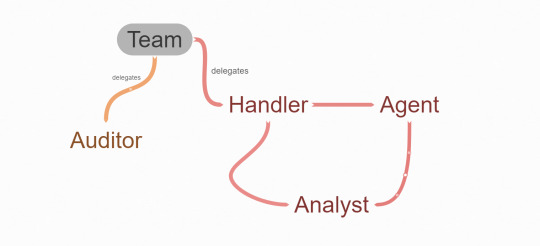
A diagram of the basic intelligence apparatus.
The basic intelligence process would go as follows: Information would be split or categorized into four main areas: strategic, campaign, logistic/operational, and tactical. For each of these levels, there would be a repeating loop process of setting goals in relation to those areas, gathering the information, analyzing it, figuring out how to use it, and a method to evaluate the process. Information can be gathered by agents or anyone else in the organization, anonymously. This helps bolster the capacity of information gathering.
So, we start by asking, what do we need to know to achieve our aims? Then, we ask about where we can find that information. As we’ll probably receive more information than what is usable, we want to ask about what information found is important, timely, and accurate/verifiable? After that, we want to ask how we can package and disseminate the information, along with an understanding of the audience(s). That leads us to review what we’ve done, integrate any changes, and start the process over. This is not to say that teams can’t do intelligence-gathering work themselves, such as scouting or information synthesis. It is just useful to have capacity specifically built for that work.
How these forms relate
Finally, we want to look at the relationship between the organizational forms, and how these forms change, depending on what the specific organization does. We can do this by understanding how things look through the classifications of overt, covert, and clandestine.
Overt organizations act out in the open. They operate in a mode where what you see is what you get. Phantom cells might operate as front-facing aboveground collectives of folks who have a very specific focus, with the intent to popularize and virally spread action around that focus, through building (para)social relationships. Networked guerrillas might make more intentional, long-term connections between cells, leading to a more tightly bound network. This could look like the mesh model. Fractal teams might have highly accessible and legible teams and assemblies with centralized information pipelines, creating an easy way to get involved with the movement. This point is important when we’re thinking about how to make the movement accessible.
Covert organizations act in secret, operating on the mode of plausible deniability. Phantom cells might use mainstream channels to share their ideas but operate in a way that obscures their identities. Networked guerrillas might have the cells be related using a star model, with many connections compartmentalized by those shared nodes. Fractal teams might hide membership and focus on the intake process because this formation is the most vulnerable to infiltration. Maybe this formation isn’t useful outside of the overt context.
Clandestine organizations are fully underground. Phantom cells might only spread action through hyper-encrypted or low-tech methods. Networked guerrillas might have no awareness of who or what the composition is of other teams in the network, and any connections between cells might be mediated in ways that maintain anonymity and prevent infiltration. Fractal teams likely would be a great weakness in this context.
Looking at all of these forms, across different modes of operating, we should not “pick” one form or the other in a dogmatic way. Each form should see the others as providing something of value towards anti-authoritarian ends. In other words, fractals should not decry networks or phantoms for their seemingly chaotic structures or methods. Phantoms shouldn’t shit on the other two for not being effective enough. Aligning people and actions across these horizontal forms will allow an ecosystem of forms that reinforces the ability of each to succeed. Overt groups can act as an auxiliary force for the covert and clandestine groups, and the covert and clandestine groups can create spaces for the overt groups to construct the world they are all working for.
By having principles and ethics that are sound, exploring what organizations need to do, and creating structures that enable those ethics and principles to be realized, we can have social technologies that allow us to more easily accomplish the social change that we’re seeking.
#direct action#solarpunk#social revolution#social relations#socialism#anarchism#anarch#anarchocommunism#anarchist#organizing strategy#organizing#insurrection#council communism#councilism#libertarian socialism#anarchy#leftist#leftism#anti state#antistate#anticapitalism#anti capitalism#organization#organização#organización
22 notes
·
View notes
Text

You don't need glue to hold these materials together—just electricity
Is there a way to stick hard and soft materials together without any tape, glue or epoxy? A new study published in ACS Central Science shows that applying a small voltage to certain objects forms chemical bonds that securely link the objects together. Reversing the direction of electron flow easily separates the two materials. This electroadhesion effect could help create biohybrid robots, improve biomedical implants and enable new battery technologies. When an adhesive is used to attach two things, it binds the surfaces either through mechanical or electrostatic forces. But sometimes those attractions or bonds are difficult, if not impossible, to undo. As an alternative, reversible adhesion methods are being explored, including electroadhesion (EA). Though the term is used to describe a few different phenomena, one definition involves running an electric current through two materials causing them to stick together, thanks to attractions or chemical bonds. Previously, Srinivasa Raghavan and colleagues demonstrated that EA can hold soft, oppositely charged materials together, and even be used to build simple structures. This time, they wanted to see if EA could reversibly bind a hard material, such as graphite, to a soft material, such as animal tissue.
Read more.
13 notes
·
View notes
Text
The Future of Television: an Introspection
I think we are at a transition point

This story begins in the Los Angeles airport, LAX. Earlier that day, I had a flight scheduled to fly from Burbank to Cincinnati (with a layover in Atlanta) to visit my parents. The flight, unfortunately, was delayed due to weather conditions, so the airline booked me for a or straight flight to CVG. After making my way over to LAX, I noticed the TV near a bar near where I was sitting- and something caught my eye.
An advertisement: for Disney+, Hulu, and Max for $17 with ads, and $30 with ads.
First of all, that's too inexpensive. With previous cable packages exceeding $100 a month, having 3 of the largest and most well known streaming services together in a single deal for less than a third of that previous price is simply unsustainable. My guess – is this deal is introductory pricing to get people used to this bundle as a norm, after which the price can slowly increase without much customer loss.
Secondly, why? Disney and Hulu makes sense, Disney owns Hulu, but Max? Max is owned by WarnerBros. Discovery, one of the largest companies in the video streaming space, and Max itself is a direct competitor to Disney+. What would they have to benefit from cooperation?
Here’s what they have to benefit:
Firstly - some business terms
A knock on the door is heard. Claire opens the door. BYSTANDER enters looking confused. Bystander: I thought this essay was about television? Claire: You thought making television was about making television? Bystander shrugs. Claire: Unfortunately... it's about the money >:3

Economies of scale is an economic principle indicating that the more you produce of something, the less it costs per item to produce. If I want to make 1 copy of The Glass Scientists by Sage Cotugno (a very good graphic novel you should read ( ᵔ ⩊ ᵔ )), it might take me 5-10 hours to print out the pages, bind them together, cut out the cover, glue the whole thing, etc.
If the cost of the materials is, let’s say, $7.00, but it takes 7 hours to make (at $25 an hour, because I’m an expensive bitch (¬‿¬ )) - then it costs this hypothetical company $182 to make this one book. That means you as a consumer would be charged around $200 - very expensive (>﹏<).
On the other hand, if I want to make 10,000 copies of this book, and I have $100,000 dollars lying around (as one does), I can buy an industrial book printing machine for $30,000, and even with 30 hours of labor, it still costs:
Labor - 30 hours of work * $25/hr = $750 Materials - $7 per book * 10,000 books = $70,000 Cost of Equipment - $30,000 Total Cost - $100,750 Cost per book - $100,750 / 10,000 books = $10.075
about $10 per book, which, in terms of individual cost, is a huge difference from our first estimate of $182.
Now, to be frank, these numbers are all bogus. I have no idea how much it costs to make a book - but the principle is the same with real numbers.
When your production scales up, your cost per product goes down. Massive corporations don’t build megafactories because they like the aesthetic: they do it because it saves them money.
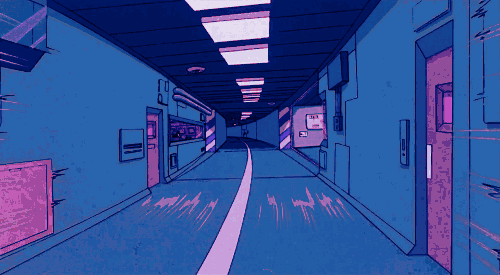
Now, this makes sense for physical products like books, but it also applies to intangible goods, like software, or web design, or streaming technology infrastructure (ding ding ding).
From a business standpoint it doesn’t make sense for 6 different companies to develop 6 different compression algorithms, and have 6 different interfaces to connect to 6 different data centers to do exactly the same thing: take an uncompressed ISO file, compress it for streaming, and send it to your device.
I personally think this is why we are seeing a lot of corporate consolidation in our current era of streaming – because, from a distributor perspective, it makes sense for all companies in the space to work together - or at least consolidate into a much smaller number of players.
But that’s only one-half of the story:
Seeing these companies merge and bundle was not what originally got me thinking about this whole, media market structure thing.
What got my gears turning was something a lot closer to what I actually care about.
Over the past couple of years, it’s been very disheartening to see many wonderful and amazing series get cut short for seemingly no reason.
I love Inside Job. Shion Takeuchi’s sense of comedy, combined with the fondness and criticalness the show has for Reagan makes her growth feel so authentic! I love seeing what she's doing, when she is in over her head, figuring out what she wants out of life. It’s amazing and funny and incredible.
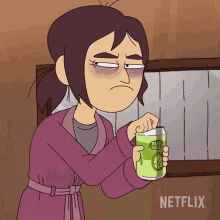
I love Scavenger’s Reign! Joseph Bennett and Charles Huettner and everyone on the crew do such an amazing job at crafting this eerie fascination for biology. I can totally see the show, and Joseph Bennett’s narrative style, becoming seminal in science fiction later on. Amazing work.
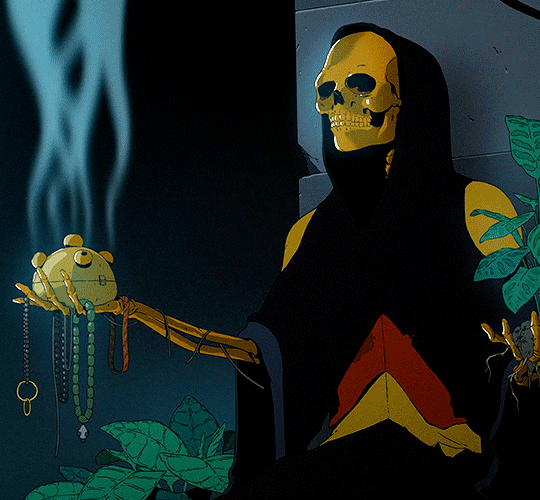
The Owl House! An amazing Disney show created by an amazing person loved dearly by many amazing people. (you can also replace the word amazing with the word gay and it still works! (o^ ^o))
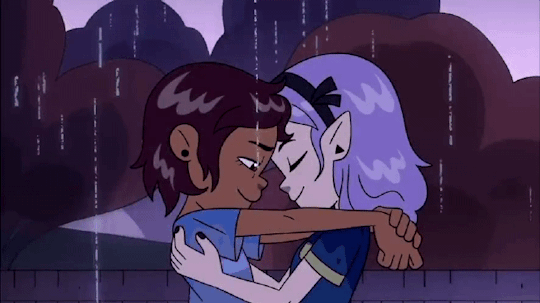
Inside Job wasn't renewed for a season 2 by Netflix. Owl House had its season 3 cut short. Scavenger’s Reign wasn’t renewed by Warner Bros. Discovery, was brought over to Netflix, and then was canceled by Netflix!
To be honest, I don’t know everything about television production. I want to learn and I want to discover but at this point in time I don’t have a clear answer of why these shows were canceled.
Dana Terrace has stated that The Owl House was canceled without her input, which is incredibly disheartening to hear.
Netflix hasn’t made an official statement about the reasons for Inside Job being canceled or Scavenger’s Reign - but I have a theory about what’s going on
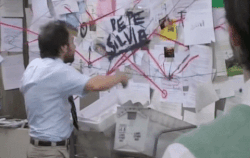
Remember when I mentioned economies of scale? Well, there’s an inverse economic principle called diseconomies of scale. Diseconomies of scale indicates that at a certain scale, as production gets larger, the cost per item gets more expensive, rather than less expensive. This can be due to a whole basket of factors, from increasing organizational costs, to transportation and distribution costs, etc. It’s the reason why there isn’t 1 factory that makes all the paper towels in the world. If economies of scale were an absolute rule, that single factory would be the standard, but it’s not. There are certain economic advantages to having multiple smaller factories rather than 1 giant factory (transportation, distribution, etc.).
There are economic reasons for a company to scale up production, but there are also economic reasons for a company to scale down or split production. When companies are at an equilibrium between economies of scale and diseconomies of scale, they are operating at their maximum market efficiency.
So, how does this apply to streaming companies?
Well, I mentioned before my theory that streaming companies are consolidating due to economies of scale from a distributor perspective, but these companies aren’t just acting as content distributors, they’re also acting as content producers.
Ye Old Media Wisdom Having a single company as a distributor and a producer is a bad idea. -me just now :)
Here’s why:
One of the aspects of diseconomies of scale is the problems with large organization. As a company gets larger, it becomes more and more difficult for people to communicate up and down the ladder and to communicate with different departments across the company. If your company is making something easily measured, like paper towels, your company can be both large and successful (like P&G) because the measurements of what makes a paper towel valuable for the consumer and for the company are easily communicated between teams. If a team is able to make a paper towel 10% more absorbent with a 2% increase in weight, it’s easy to communicate that possible change to a higher up - and their decision, whether to proceed with that change or not, will be made with most of the important details needed for that decision, primarily because those details are easy to communicate.
Making entertainment, especially animated entertainment, is something that is much more complex, subjective, and harder to communicate than paper towels. Different series appeal to different people, different shows have different voices, and being able to communicate the benefits of a series to a friend is challenging, let alone an executive 3 organization levels up. Additionally, making an impactful and amazing series takes risks! All great storytelling is communicating a perspective that is unique and engaging, but to make something unique is by definition to make something new, which requires risk. Larger companies are more risk averse than smaller companies: they have more to lose, are harder to change, and adapt less quickly. For a company whose primary purpose is to make stories that people engage with, being larger is, unfortunately, antithetical to that goal. People who want to make something different deal with more red tape, more bureaucracy, and more people their story has to please. It becomes harder and harder to make something that is new and impactful - to put it another way, it becomes harder to make something successful.
In my opinion, many of the recent releases of Disney feel… generic. Lightyear, Strange World, Wish - these films are by no means made by people without skill or character, but if those people are not allowed to take risks, if they’re not allowed to make anything outside the lowest common denominator of opinions, then the perspective these films convey is destined to be bland and uninteresting.
In my opinion, this is why companies like Riot / Fortiche and Sony Pictures Animation have been kicking ass recently. Spider-Verse, Mitchells and Arcane are amazing and seem to have the support and space they need. Since Riot and Sony Pictures Animation aren’t distributors, they don’t have the same pressure to become a larger company themselves. They can stay the size they want and continue to produce animation at a quality and risk level they are comfortable with.
I don’t know exactly what’s going on inside these companies, there might be other factors that contribute to their success - but I do know that making TV is hard. Making anything at a studio level is hard. Many people have to spend months of their lives working, communicating, and trying to discover what this thing they’re working on is. When people working on these series not only make something, but make something incredible - and after all that, are not be supported?
well, that’s just bad business

Epilogue
So where do we go from here?
Well if I were in charge of the largest media corporations on the planet, I’d say: spin off your animation production companies into their own entities and act, primarily, as the best distributor on the market. This will allow for you to remain as the larger corporate entity you want to be but remove the bureaucratic restrictions on production companies. Additionally, it gives the distributor more choices! Now they don’t only stream your own content, they can stream anyone else’s if they want! If another, better player comes into town, making more popular media, they can stream their shows instead. Production companies get the freedom to make great things, distributors get the structure and size that they need, and consumers, because of the competition between the two, get the best deal for their money.
This is what cable TV was in my opinion: one or 2 big distributors offering the same service, and many smaller production companies making the things we love.
Ideal market structure for media distributors, I think, is 1 or 2 big companies.
Ideal market structure for media producers, however, is many smaller companies.
It will take time, but I think we’ll get to this market structure eventually – or something new might come along, who can say (ᵔ ⩊ ᵔ)
In the meantime, I wish a tremendous amount of support to the artists and individuals who make the animation and series that we all love.
Y’all are why any of this exists in the first place – don’t forget that.
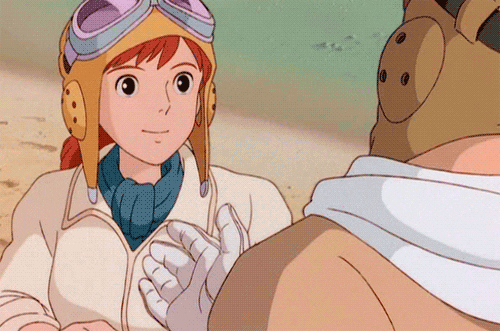
-Claire
4 notes
·
View notes
Text
Re-animate the city.
Below I am attempting to preserve two threads that I posted to Twitter on 31 May 2019 and 28 September 2020. Twitter search is broken and I can’t even find a link to them anymore, but fortunately I do have some screenshots, which I have used to recreate them here. (And only once finished, I found a link to one of them in my bookmarks.)
The first thread (31 May 2019) is largely a set of pull quotes from the fantastic “Magic and the Machine“ by David Abram, which I had read thanks to my friend Anne Galloway, who I tagged as I posted, and which I also recommend reading in full.
“Only as our senses transferred their animating magic to the written word did the other animals fall dumb, the trees and rocks become mute. For, to learn this new magic, we had to break the spontaneous participation of our eyes and ears in the enfolding terrain in order to recouple those senses with the flat surface of the page.”
[…]
“far from enacting a clear break with animism, alphabetic literacy can be recognized as a particularly potent form of animism, one which shifts the locus of magic—or meaning—away from our interactions with the more-than-human surroundings to the relation between ourselves and our own signs.”
[…]
“different technologies tend to capture and channel our instinctive, animistic proclivities in particular ways.”
[…]
“Despite the flimsy gesture toward a kind of magical reality, the fact is that we’re still speaking only to ourselves, to things that we have programmed to talk back to us.”
[…]
“The difficult magic of animistic perception, the utter weirdness and dark wonder that lives in any deeply place-based relation to the earth, is the felt sense of being in contact with wakeful forms of sentience that are richly different from one’s own […]”
[…]
“As we enter more deeply into the world of ubiquitous computing, we increasingly seal ourselves into an exclusively human zone of interaction. We enter into a bizarre kind of intraspecies incest.
“Yet it’s the alterity or otherness of things—the weirdly different awareness of a humpback whale sounding its eerie glissandos through the depths, or an orb-weaver spider spinning the cosmos out of her abdomen; or the complex intelligence of an old-growth forest, dank with mushrooms and bracket fungi, humming with insects and haunted by owls—it’s the wild, more-than-human otherness of these powers that makes any attentive relation with such beings a genuine form of magic, a trancelike negotiation between outrageously divergent worlds. “Without such radical otherness, there’s no magic. Wandering around inside a huge extension of our own nervous system is not likely to bring a renewal of creaturely wonder, or a recovery of ancestral capacities.”
On GPS: “instead of this knowledge arising from our bodily interchange with the earthly cosmos, here the knowledge arrives as a disembodied calculation by a complex of orbiting and ground-based computers.”
On traditional hunting and foraging: “sensory perception functions here as a kind of glue, binding one’s individual nervous system into the larger ecosystem.”
[…]
“Instead of divesting ourselves of the place where we find ourselves, this more ancient form of clairvoyance involves tuning one’s body so thoroughly to the terrain that we ourselves become fully a part of the sensate surroundings.”
[…]
“we remain transfixed by these tools, searching in and through our digital engagements for an encounter they seem to promise yet never really provide: the consummate encounter with otherness, with radical alterity […]”
I concluded that thread with the following, which gets to the phrase I used to title this post:
If you are interested in some more reading on animism, I have a growing collection here. Meanwhile, I’ll soon head out for a walk to re-animate the city and catch up with @derekcz [my friend Derek]. Happy Friday, folks!
(We meet for and adventure – usually a walk, often including a ride on public transit, occasionally involving and event – in San Francisco or surroundings every week. Please reach out if you’d like to join sometime.)
In the second thread (28 September 2020) I eventually referenced the first thread, but it started like this:
Thanks to a request for reading material on crows today, I am re-reading this wonderful 2017 piece (“The Secret Life of Urban Crows”) featuring @corvid research [Kaeli Swift].
“She was eight years old and she had trouble reading. The Spokane elementary school she attended in the mid-1990s wanted to hold her back a grade. Was something wrong with her? Sometimes she wondered. The pediatrician had her on Ritalin. She hated Ritalin. It left her feeling separate, other.
“She was a curious girl, though, and wildlife in the hills around Spokane kept her rapt. She pushed herself to read so she could learn more about them: the Sawtooth wolf pack, which stalked the mountains of nearby Idaho.”
“By the time her family moved to the Seattle suburb of Mercer Island in the early 2000s, Kaeli Swift could read, had kicked Ritalin, and knew science was her jam.”
Nature beats school again. :)
And a completely separate thought:
There are many many reasons why “smart cities” and “digital animism” are sillyscary, but the best one might be that cities have always been smart and animate thanks to the more than human
Re-animate the city.
And that pointed back to the other thread, specifically the tweet with the link to my collection of references on animism. But I want to conclude this post with that last phrase, so I repeat:
Re-animate the city.
#animism#multispecies#more than human#urban#urbanism#unschooling#walking#re-animating the city#cities#corvids#crows#David Abram#nature#digital animism#smart cities#smart city#technology#GPS
6 notes
·
View notes
Text
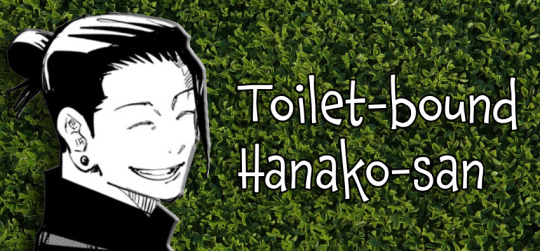
Ch. 15 - A Life Realized
By the time you had arrived at a hospital and were taken back you were passed out from the pain. Ieiri's technique could only hold you together like glue before the wounds opened again, your detached nerves screaming to be put back together permanently again.
The pain didn't subside much when you found yourself slowly waking up from the anesthesia after a grueling surgery.
"Ugh," you groaned as your eyelids flickered open. Suguru, who was once focused in silence, holding your hand with his eyes shut, sat up quickly and at attention with a small smile.
You looked around the room to familiarize yourself with your surroundings. You'd obviously been to the hospital in your former life, but this room was on another level. Technology was so far advanced that you could hardly even recognize even the bed you were lying in. You squinted your eyes as the light penetrated through the thin, white blinds at the window. As soon as you were able to focus, you saw Suguru smiling up at you from his seat. His hand was still firmly wrapped around yours as he eagerly awaited your acknowledgement.
"Hi," your voice cracked as you looked at him, his warm eyes happily greeting you out of your slumber.
"Hi," he replied, "I'm so glad you're awake. Things got real intense during your surgery. They were afraid that you weren't going to pull through," he gave a small laugh of relief. "You've been asleep for quite some time."
"How long is 'some time?'" You hesitantly asked.
Suguru awkwardly looked away as he prepared to give you the answer, "about a week."
"A week?!" You nearly shouted, starting to sit up but instead wincing at the pain at the center of your body.
"Careful," Suguru advised, coming to a stand to assist you in laying back down. "You've got a nice pair of stitches."
"Right," you nodded gently. You took a deep breath, slowly, as you finished easing into the waking world. Immediately you noticed that weird feeling. "Have they figured anything out about the binding vow?"
"That," Suguru nodded and sat back down in his seat. "We...Satoru and I...talked to Tengen while you were recovering. He has an idea of what may have happened."
"Okay?" You urged him on when he finished, giving no sign of continuing. It was as if he were reluctant to say.
"Okay," Suguru nodded, "tell me," he held up his palm so it faced the ceiling. The gesture seemed strange at first, until you realized what was happening. "Can you see it?"
You gave a deep frown when his palm remained empty. You shook your head. "Let me guess, you conjured something."
Suguru nodded. "Then it seems Tengen was right," he flattened his lips in a bit of disappointment. "Your cursed technique, it's gone. As is your ability to see curses." The flattening of his lips then turned into a smile. "Your corporealization and immortality was part of that which means..."
"Which means I'm normal!" You shot up in happiness, again neglecting your stitches. Tears welled up in your eyes as the stinging pulsed through your body. Suguru chuckled at your demeanor.
"It means you're free, completely free," he nodded.
The relief and joy flooded your senses as you realized the significance of Suguru's words. You couldn't help but smile through the pain, tears of happiness glistening in your eyes. "I'm free," you whispered, the words carrying a weight that transcended the physical pain you were feeling.
Suguru's smile grew wider as he watched your reaction, his eyes filled with a deep and unwavering affection. "Yes," he confirmed, "you're finally free. You have your physical body back for good, and you can live a normal life."
You took a moment to let it all sink in, and as you did, you couldn't help but feel overwhelmed by the love that had grown between you and Suguru during the past week together. The loss of your cursed technique and immortality were small prices to pay for the chance to be truly alive again, especially when you had Suguru's unwavering love and support. This time, you had the chance to finish your lifetime together.
"Thank you," you said, your voice filled with genuine gratitude as you turned to Suguru, your eyes locked with his. "Thank you for being there for me, for helping me through all of this."
Suguru's expression softened even further, and he leaned in closer, his lips gently brushing against yours in a sweet and tender kiss. "Of course," he replied, his voice sincere and filled with love. "I promised to look out for you, and I intend to keep that promise, now and forever."
As you lay there, you couldn't help but feel a deep and profound connection to Suguru. You had lost your supernatural abilities, but you had gained something even more precious: a love that was stronger than any curse or obstacle, one that transcended a lifetime.
With a loving smile on your face, you whispered, "I'm looking forward to this new chapter of my life, Suguru."
"Suguru, I've found her!" Satoru's voice suddenly sang into the room. His arms were outstretched wide as he burst through the door, a big smile on his face. "Oh, and Y/N, you're awake! How do you feel?"
You laughed at his playful demeanor, "as good as I can be," you assured him. "But who did you find? Who's her?"
Satoru looked to Suguru, almost as if for permission. Suguru gave him a nod to which his excited tone continued. "Since you've been asleep, I've been doing more research on your family. And...your younger sister, who we knew to still be alive..." your attention was perked, eyes flickering with excitement as you knew what was coming. "We found her."
"You...found her?" You nearly gasped, a growing smile sweeping across your face.
Satoru nodded, but his smile started to fade. "But...as you know, she's really old, ancient even..."
"Gojo," Suguru hissed at his friend.
"I know, I know," Satoru shook his head, "I just don't know how to say this," he gave a small, awkward chuckle. "She may not remember you at all. The retirement home she's staying at...she's the oldest resident and she's been struggling with dementia for some time, so..."
Your heart raced with a mix of anticipation and anxiety at the news. It was a bittersweet moment, the possibility of reuniting with your younger sister after all these years weighed against the heartbreaking reality of her condition. But what else could you expect? You'd been gone for decades.
Suguru gently squeezed your hand, offering you silent support as you processed the information. "Thank you, Satoru, for finding her," he said in your stead, his voice filled with gratitude.
Satoru nodded, relief washing over his features as he realized you were taking the news better than he'd feared. "I told them that we'd be visiting soon, but you'll have to be patient and gentle with her. It's been a long time, and she might not remember much."
You nodded, determination in your eyes. Though the news was bittersweet, it was as if it had rejuvenated you. "I'll do whatever it takes to be there for her." Suguru squeezed your hand in support, giving a warm smile when you met his eyes.
Satoru cleared his throat, feeling a bit awkward about the emotional moment he had inadvertently caused. "Well," he said, trying to lighten the mood with his classic smile, "we'll work out the details for the visit and let you know. For now, focus on getting better."
You nodded, your heart still filled with both hope and love. The future might hold challenges, but with Suguru by your side and the possibility of reuniting with your sister, you felt ready to face whatever came your way.
#geto suguru x y/n#geto suguru x you#geto suguru x reader#getou suguru x you#getou suguru x reader#suguru geto x you#suguru geto x y/n#suguru geto x reader#suguru getou x you#suguru getou x y/n#suguru getou x reader#jjk#jujutsu kaisen#suguru geto#geto suguru#suguru getou#getou suguru
11 notes
·
View notes
Text
Why Choose Selenium? Exploring the Key Benefits for Testing and Development
In today's digitally driven world, where speed, accuracy, and efficiency are paramount, web automation has emerged as the cornerstone of success for developers, testers, and organizations. At the heart of this automation revolution stands Selenium, an open-source framework that has redefined how we interact with web browsers. In this comprehensive exploration, we embark on a journey to uncover the multitude of advantages that Selenium offers and how it empowers individuals and businesses in the digital age.

The Selenium Advantage: A Closer Look
Selenium, often regarded as the crown jewel of web automation, offers a variety of advantages that play important roles in simplifying complex web tasks and elevating web application development and testing processes. Let's explore the main advantages in more detail:
1. Cross-Browser Compatibility: Bridging Browser Gaps
Selenium's remarkable ability to support various web browsers, including but not limited to Chrome, Firefox, Edge, and more, ensures that web applications function consistently across different platforms. This cross-browser compatibility is invaluable in a world where users access websites from a a variety of devices and browsers. Whether it's a responsive e-commerce site or a mission-critical enterprise web app, Selenium bridges the browser gaps seamlessly.
2. Language Flexibility: Your Language of Choice
One of Selenium's standout features is its language flexibility. It doesn't impose restrictions on developers, allowing them to harness the power of Selenium using their preferred programming language. Whether you're proficient in Java, Python, C#, Ruby, or another language, Selenium welcomes your expertise with open arms. This language flexibility fosters inclusivity among developers and testers, ensuring that Selenium adapts to your preferred coding language.
3. Interaction with Web Elements: User-like Precision
Selenium empowers you to interact with web elements with pinpoint precision, mimicking human user actions effortlessly. It can click buttons, fill in forms, navigate dropdown menus, scroll through pages, and simulate a wide range of user interactions with the utmost accuracy. This level of precision is critical for automating complex web tasks, ensuring that the actions performed by Selenium are indistinguishable from those executed by a human user.
4. Automated Testing: Quality Assurance Simplified
Quality assurance professionals and testers rely heavily on Selenium for automated testing of web applications. By identifying issues, regressions, and functional problems early in the development process, Selenium streamlines the testing phase, reducing both the time and effort required for comprehensive testing. Automated testing with Selenium not only enhances the efficiency of the testing process but also improves the overall quality of web applications.
5. Web Scraping: Unleashing Data Insights
In an era where data reigns supreme, Selenium emerges as a effective tool for web scraping tasks. It enables you to extract data from websites, scrape valuable information, and store it for analysis, reporting, or integration into other applications. This capability is particularly valuable for businesses and organizations seeking to leverage web data for informed decision-making. Whether it's gathering pricing data for competitive analysis or extracting news articles for sentiment analysis, Selenium's web scraping capabilities are invaluable.
6. Integration Capabilities: The Glue in Your Tech Stack
Selenium's harmonious integration with a wide range of testing frameworks, continuous integration (CI) tools, and other technologies makes it the glue that binds your tech stack together seamlessly. This integration facilitates the orchestration of automated tests, ensuring that they fit seamlessly into your development workflow. Selenium's compatibility with popular CI/CD (Continuous Integration/Continuous Deployment) platforms like Jenkins, Travis CI, and CircleCI streamlines the testing and validation processes, making Selenium an indispensable component of the software development lifecycle.
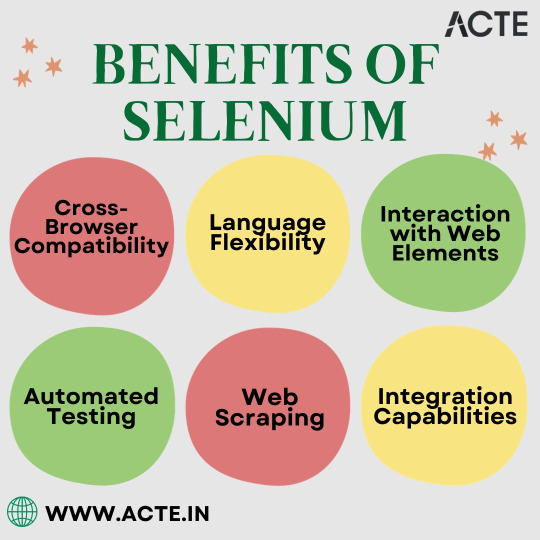
In conclusion, the advantages of using Selenium in web automation are substantial, and they significantly contribute to efficient web development, testing, and data extraction processes. Whether you're a seasoned developer looking to streamline your web applications or a cautious tester aiming to enhance the quality of your products, Selenium stands as a versatile tool that can cater to your diverse needs.
At ACTE Technologies, we understand the key role that Selenium plays in the ever-evolving tech landscape. We offer comprehensive training programs designed to empower individuals and organizations with the knowledge and skills needed to harness the power of Selenium effectively. Our commitment to continuous learning and professional growth ensures that you stay at the forefront of technology trends, equipping you with the tools needed to excel in a rapidly evolving digital world.
So, whether you're looking to upskill, advance your career, or simply stay competitive in the tech industry, ACTE Technologies is your trusted partner on this transformative journey. Join us and unlock a world of possibilities in the dynamic realm of technology. Your success story begins here, where Selenium's advantages meet your aspirations for excellence and innovation.
5 notes
·
View notes
Text
Best certification course academy in mumbai
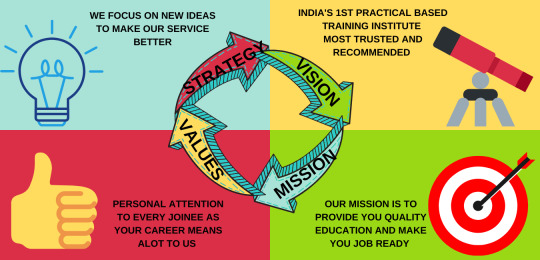
1.Upsurge Infotech - Practical knowledge is the key to success, and Upsurge Infotech, the best training institute in Mumbai, provides you with just that. With a team of experienced and certified professionals who have years of expertise in their respective fields, we offer comprehensive training programs in Software Testing, Digital Marketing, SAP ERP, Python, and other emerging technologies.
SoftwareTesting Courses in Mumbai
If you’re interested in learning about software testing courses in Mumbai then Upsurge Infotech has several courses and resources available that can help you develop your skills in this field. Software testing is a crucial process in the software development life cycle (SDLC) that involves evaluating a software application’s functionality, performance, and quality to identify any defects or errors. The goal of software testing is to ensure that the software meets the requirements, works as expected, and delivers a satisfactory user experience.
SAPCourses In Mumbai
If you’re interested in learning about SAP courses in Mumbai then Upsurge Infotech has several courses and resources available that can help you develop your skills in this field. SAP’s ERP software, known as SAP ERP, is one of their flagship products and provides comprehensive solutions for financial management, procurement, sales, production, and other core business functions. It enables businesses to consolidate their data, automate processes, and gain real-time insights into their operations.
DigitalMarketing Course in Mumbai
If you’re interested in learning Digital Marketing Course in Mumbai then Upsurge Infotech can help you develop your skills in this field. Digital marketing, in its most basic form, refers to any online marketing activities or properties. Email marketing, pay-per-click advertising, social media marketing, and even blogging are all examples of digital marketing that help people learn about your business and buy from you.
PythonCourse in Mumbai
If you’re interested in learning Python Course in Mumbai then Upsurge Infotech can help you develop your skills in this field. Python is a dynamically semantic, interpreted, object-oriented high-level programming language. Its high-level built-in data structures, together with dynamic typing and dynamic binding, making it ideal for Rapid Application Development and as a scripting or glue language for connecting existing components.
DataAnalyst Course in Mumbai
If you are searching for a Job that doesn’t require coding, then this digital analyst course in Mumbai is right for you. Upsurge Infotech offers a Data Analyst Training program it is the process of systematically applying statistical logical techniques to describe and illustrate, condense and recap, and evaluate data. To put it simply it’s a process in which an analyst Works with data to extract relevant information that may be used to guide decisions known as data analysis.
Mumbai Location: 2A-20, 3rd Floor, Viviana Building, inside Super Shopping Centre, near Khadi Gram Udyog, Swami Vivekananda Rd, next to T-10 showroom, Andheri West, Mumbai, Maharashtra 400058.
Thane Location: 602, 6th Floor, Ganesh Tower, Opp Thane West Platform #1, Dada Patil Wadi, Thane (W) - 400602.
2.LearnCoz - LearnCoz is a reputed computer institute located at 512, 2, Kalyan - Bhiwandi Road, Sapna Industrial Estate, Saravali, Mumbai. Our institute offers a wide range of computer courses to help individuals enhance their skills and stay competitive in the ever-evolving IT industry. Join us and unleash your potential in the world of computers.
3.DatapointComputer - Datapoint Computer is a renowned computer training institute based in Mulund West, Mumbai. Situated at 52 Saidham Arcade, P K Road, we offer high-quality computer training courses to help students acquire the skills needed to thrive in the IT industry. Join us and unlock your potential in the world of computers.
4.Wiztech - Wiztech is a leading institute providing software training with 100% placement assistance. Located at 4B/29, Phoenix Paragon Plaza, LBS Marg, Kurla West, Mumbai, we offer comprehensive courses that cover various software technologies. Upgrade your skills and secure a promising career in the IT sector with Wiztech.
5.VDMA - VDMA offers comprehensive courses in Digital Marketing, SEO, PPC, Wordpress, and Social Media. Located at Taximens Colony, 2B, 64, 6th Floor, LBS Marg, Kurla West, Mumbai, our institute equips students with the necessary skills to thrive in the digital world. Upgrade your digital marketing skills and unlock exciting career opportunities.
6.DGmarkInstitute - DGmark Institute is a highly acclaimed Digital Marketing Training Institute situated at 23, Ground Floor, Harmony Mall, New Link Road, Sejal Park, Colony No 1, Bhagat Singh II, Goregaon West, Mumbai. We provide top-notch training in digital marketing, equipping students with the knowledge and skills needed to excel in the digital era.
7.LIPSINDIA - LIPSINDIA is a premium destination for Digital Marketing Training in Mumbai. Located at 3/A Vrindhavan Bldg, Gr Floor, Behind Pantaloons, Umeda Ashram Road, Borivali West, Mumbai, we offer comprehensive courses that cover various aspects of digital marketing. Enhance your knowledge, upgrade your skills, and stay ahead in the competitive digital landscape.
8.ExcelRSolutions - ExcelR Solutions is your gateway to mastering Business Analyst Course. Located at 304, 3rd Floor, Pratibha Building, Three Petrol Pump, Opposite Manas Tower, Lal Bahadur Shastri Road, Pakhdi, Mumbai, our institute provides comprehensive training that is adaptable to everyone. Enhance your business analysis skills and open doors to new career possibilities.
9.Livewire - Livewire is a renowned IT institute located at 2B,22, Vivina, Apartment, Nadco Shopping Centre, Opposite Andheri Railway Station, S.V.Road, Andheri West, Mumbai. Our institute offers a wide range of courses, including web designing and IT-related disciplines. Upgrade your skills and unlock exciting career opportunities in the IT industry.
10.ChaloDigitalMarketingInstitute - Chalodigital Marketing Institute is your ultimate destination to learn awesome social media hacks and digital marketing strategies. Located at Raghuleela Mall Office No 310, First Floor, Behind Poisar Bus Depot, Boraspada Road, Jai Bhim Sanjay Nagar, Kandivali, Mumbai, our institute provides expert training in digital marketing to help individuals excel in the digital landscape.
2 notes
·
View notes
Text
Migrating Virtual Machines to Red Hat OpenShift Virtualization with Ansible Automation Platform
As enterprises modernize their infrastructure, migrating traditional virtual machines (VMs) to container-native platforms is no longer just a trend — it’s a necessity. One of the most powerful solutions for this evolution is Red Hat OpenShift Virtualization, which allows organizations to run VMs side-by-side with containers on a unified Kubernetes platform. When combined with Red Hat Ansible Automation Platform, this migration can be automated, repeatable, and efficient.
In this blog, we’ll explore how enterprises can leverage Ansible to seamlessly migrate workloads from legacy virtualization platforms (like VMware or KVM) to OpenShift Virtualization.
🔍 Why OpenShift Virtualization?
OpenShift Virtualization extends OpenShift’s capabilities to include traditional VMs, enabling:
Unified management of containers and VMs
Native integration with Kubernetes networking and storage
Simplified CI/CD pipelines that include VM-based workloads
Reduction of operational overhead and licensing costs
🛠️ The Role of Ansible Automation Platform
Red Hat Ansible Automation Platform is the glue that binds infrastructure automation, offering:
Agentless automation using SSH or APIs
Pre-built collections for platforms like VMware, OpenShift, KubeVirt, and more
Scalable execution environments for large-scale VM migration
Role-based access and governance through automation controller (formerly Tower)
🧭 Migration Workflow Overview
A typical migration flow using Ansible and OpenShift Virtualization involves:
1. Discovery Phase
Inventory the source VMs using Ansible VMware/KVM modules.
Collect VM configuration, network settings, and storage details.
2. Template Creation
Convert the discovered VM configurations into KubeVirt/OVIRT VM manifests.
Define OpenShift-native templates to match the workload requirements.
3. Image Conversion and Upload
Use tools like virt-v2v or Ansible roles to export VM disk images (VMDK/QCOW2).
Upload to OpenShift using Containerized Data Importer (CDI) or PVCs.
4. VM Deployment
Deploy converted VMs as KubeVirt VirtualMachines via Ansible Playbooks.
Integrate with OpenShift Networking and Storage (Multus, OCS, etc.)
5. Validation & Post-Migration
Run automated smoke tests or app-specific validation.
Integrate monitoring and alerting via Prometheus/Grafana.
- name: Deploy VM on OpenShift Virtualization
hosts: localhost
tasks:
- name: Create PVC for VM disk
k8s:
state: present
definition: "{{ lookup('file', 'vm-pvc.yaml') }}"
- name: Deploy VirtualMachine
k8s:
state: present
definition: "{{ lookup('file', 'vm-definition.yaml') }}"
🔐 Benefits of This Approach
✅ Consistency – Every VM migration follows the same process.
✅ Auditability – Track every step of the migration with Ansible logs.
✅ Security – Ansible integrates with enterprise IAM and RBAC policies.
✅ Scalability – Migrate tens or hundreds of VMs using automation workflows.
🌐 Real-World Use Case
At HawkStack Technologies, we’ve successfully helped enterprises migrate large-scale critical workloads from VMware vSphere to OpenShift Virtualization using Ansible. Our structured playbooks, coupled with Red Hat-supported tools, ensured zero data loss and minimal downtime.
🔚 Conclusion
As cloud-native adoption grows, merging the worlds of VMs and containers is no longer optional. With Red Hat OpenShift Virtualization and Ansible Automation Platform, organizations get the best of both worlds — a powerful, policy-driven, scalable infrastructure that supports modern and legacy workloads alike.
If you're planning a VM migration journey or modernizing your data center, reach out to HawkStack Technologies — Red Hat Certified Partners — to accelerate your transformation. For more details www.hawkstack.com
0 notes
Text
The Hidden Cost of Black Streaks on Spokane County Homes

Those black roof streaks and green siding stains in #SpokaneWA, #SpokaneValleyWA, and #CheneyWA may look harmless, but they’re signs of serious structural damage waiting to happen. The culprit? Gloeocapsa magma and other moisture-loving invaders.
Neglecting your home's exterior isn’t just an eyesore—it’s a financial hazard. Veracity Gutter And Roof Cleaning, LLC (VGRC, LLC) has seen firsthand how Spokane County homes fall victim to roof rot, siding decay, and costly repairs due to avoidable GUNK buildup.
Let’s expose what’s really behind these stains—and how our soft washing pros prevent permanent damage.
1. Gloeocapsa Magma: The Black Streak Shingle Slayer
This dark, streaky bacteria loves feasting on limestone in asphalt shingles across #LibertyLakeWA and #MedicalLakeWA. Once it moves in, it:
Weakens shingles from the inside out
Reduces energy efficiency by trapping heat
Shortens roof lifespan by years
Pro Tip: If your roof is streaked, it’s not just dirty—it’s deteriorating. Soft washing halts damage fast.
2. Green GUNK: Moss, Algae & Mold Attackers
In shaded zones like #NineMileFallsWA and #OtisOrchardsEastFarmsWA, GUNK thrives. Moss and algae trap moisture like a sponge, accelerating:
Siding deterioration
Roof rot
Mold spread into your attic
Green GUNK doesn’t just lower curb appeal—it eats equity. VGRC, LLC’s soft washing eliminates it at the root.
3. Lichen: The Roof’s Super Stain
Found on shingles and siding in #FairwoodWA and #NewmanLakeWA, lichen is nature’s version of glue. It:
Binds to surfaces, requiring soft washing to safely remove
Causes long-term stains on light siding
Damages shingles and fencing over time
Why Soft Washing Beats Pressure Washing in Spokane County
Many homeowners in #GreenacresWA and #TrentwoodWA assume pressure washing is the answer—but that outdated method often causes more harm.
Here’s why soft washing wins:
Uses low-pressure to protect siding, shingles, and fencing
Delivers lasting results—up to 4x longer than pressure washing
Kills harmful growths at the root so they don’t return
Routine Maintenance: The Secret to a Long-Lasting Exterior
Waiting until ‘next season’ leads to rot, mold, and stains that don’t come out. For homes in #ColbertWA and #TownAndCountryWA, the cost of procrastination can be thousands.
Routine soft washing is the affordable way to:
Prevent moisture buildup
Keep your home’s siding and roof healthy
Avoid expensive replacements
Remember: We don’t just clean—we protect your investment.
VGRC, LLC’s 5 Core Exterior Cleaning Services
🧼 SOFT WASHING (House Washing) Safely removes algae, mold, mildew, and stains using low-pressure technology. Ideal for siding, garages, and entryways.
🍃 ROOF BLOW OFFs Removes pine needles, leaves, and GUNK buildup to prevent rot, ice dams, and rooftop freeloaders.
🌿 MOSS REMOVAL Eliminates moss at the root and treats your roof to prevent regrowth. Ideal for shaded homes in Spokane County.
🌧️ GUTTER CLEANING Clears out Clogzilla and her leafy reign of chaos. We restore flow, protect your foundation, and prep for storm season.
🛠️ VINYL FENCE WASHING Restores dingy, green-streaked fences with brightening agents and soft scrubs. Fence funk doesn’t stand a chance.
FAQs: Exterior GUNK Questions from Spokane Homeowners
Q: How often should I get my roof or siding cleaned in Spokane County?
A: We recommend routine maintenance at least once per year—twice if your home is surrounded by trees or shaded areas.
Q: Is soft washing safe for older homes or delicate siding?
A: Absolutely. Our low-pressure technique is designed to clean without damaging paint, trim, or siding.
Q: Will moss come back after treatment?
A: Our process treats moss at the root, and our ongoing care helps prevent future growth.
Final Thoughts: Don’t Let Your Home Host the GUNK
Ignoring black streaks, moss, or siding stains doesn’t save money—it multiplies future costs. VGRC, LLC helps homeowners across Spokane County—from #DishmanWA to #VeradaleWA—protect their investment with expert care.
💬 WE HANDLE THE MESS! SO YOU DON’T STRESS! (Because no one wants moss throwing a party on their siding.)
💪 WE DON’T PLAY THE PART — WE ARE THE PART! A TRUE LOCAL COMPANY! 🏠 (We know these roofs like the back of our gloves.)
✨ YOUR RECOMMENDATION IS OUR BIGGEST COMPLIMENT! (We clean with heart—and Spokane sees the difference!)
📍 Need a GUNK intervention? ☔@ VGRCLLC.com 📞 @ 509-530-1330🎯 Spokane’s Soft Wash Specialists — Book Now!
#gutter cleaning#house washing#gutter maintenance#soft pressure washing#roof washing#roof blow offs#exterior cleaning
1 note
·
View note
Text
Dev Log May 2 - Learn the Trade not the Tool
I saw this video the other day from an artist talking about how a lot of their tools from school aren't available to them any more, either because support was dropped, or the pricing model changed and it's no longer affordable for the average consumer. (It's kind of long and a little, I dunno, dark in some places? But I'd recommend a watch. Very well put together)
youtube
I am a professional software engineer, and I've previously worked for a company that makes something extremely expensive that only other companies can afford to buy, which was subsequently discontinued and left a couple of people high and dry (it was for manufacturing and not creative, and the choice to discontinue/not provide back-compat was outside of my control, so no hate mail please.) And I do have to say that it's just as frustrating for the developers working on these projects to have to bend to the whim of the business to generate more profit, which is why there's so much open source stuff available now. So, I'm bringing this up not to refute the video, but kind of caution against a certain mentality that seems to be shared among the commenters. The author explicitly calls out to make sure that you're familiarizing yourself with the fundamentals of how these different software suites operate, and not pledge allegiance to a particular product. A lot of the audience seems to think this means ditch all paid software and only go open-source. Which I want to tell you explicitly, every single issue outlined in the video still applies to the free stuff. You can get rug-pulled at any time. It's happened, and if you're not a developer, a lot more frequently than you'd know.
In an analog to the video mentioning Flash/ActionScript, most people are at at least vaguely aware of a free and open-source programming language called Python. In 2006, Python 3 was introduced, essentially made to replace Python 2 (don't ask me where Python 1 went). This made quite a few people very angry - the language itself was similar, but the syntax was not 1:1 compatible in all cases. And so, Python 2 was supported side-by-side with Python 3 for years. In 2008, they said Python 2 would be supported until 2015. But people were still angry, and then the deadline was supported until 2020. And then in 2020, people were still angry, but another camp of developers (mainly people working on OS packages) were sick of having to jump through hoops to get Python 2 building for their systems. So, officially, it's gone. If you really, really want it, you can jump through the hoops yourself to get it. Good luck finding somebody maintaining a usable fork. That's just one of the more prominent examples. You've got stuff all the time that was at one time a vital package for some ecosystem, but time marches on, and everything around it changes, and suddenly it just doesn't work any more. It's weird for the artist because, "I wrote a book, I painted a picture, it's there forever - why is software any different"? But that's actually wrong - that physical medium is not there forever. You will have to re-bind that book. You will need to re-varnish that painting. Otherwise it'll deteriorate and cease to exist. The unfortunate part about software is that with the current pace of technology, you're essentially carving a statue out of limestone and leaving it in the middle of the parkway in DC. If a semi doesn't take it out, the acid rain will get it eventually. Then somebody needs to replace it or glue it back together, if the budget is even still allocated for it in the first place.
This isn't an excuse for Adobe or any company called out in the video - cooperate greed is just completely out of control right now. I guarantee the developers working hard on those programs aren't getting a tenth of the revenue from the sales. This is just caution that the root of the problem here is one that always existed and is never going to go away even if all of these programs were suddenly made free forever to everyone. It's going to stop working at some point no matter what. Software is always only a tool to express your abilities. If your art only looks good in Photoshop, there's a major problem. If you can only code in Visual Studio or need ChatGPT to be productive, re-consider your career path. Computer programs are not an extension of yourself - they are solely a means to an end, and should never be anything more. You should always pick the best tool for the job. In some cases, that might mean shelling out a little bit for something streamlined. In others, the investment is not worth it and you might need to force yourself to learn that free program. But you always have to be remain able to drop it and pivot to some other tool. Because, just like EndVertex says there, at some point in the future, you won't have a choice.
0 notes
Text
Best Record Binding services in Kakinada | Delivers all over India | The PrintsMen

Keeping your important documents safe and organized is essential for both personal and professional purposes. At Printsmen, we offer high-quality record-binding services in Kakinada designed to meet the diverse needs of businesses, students, and individuals. Whether you need to bind office reports, project files, academic records, or personal documents, we provide a range of binding options that combine durability with a professional finish. Our advanced binding technology ensures that your documents are securely held together, making them easy to store, reference, and transport. With a focus on quick turnaround and customer satisfaction, we aim to deliver your binding orders within 1–2 days in Kakinada, helping you meet tight deadlines without compromising on quality.
Types of Record Binding for Customized Binding in Kakinada
Choosing the right binding method depends on the type of document, frequency of use, and the level of professionalism you want to project. At Printsmen, we offer a wide range of binding options to suit various business and personal requirements. Each option is customizable to reflect your brand identity and document structure. Our goal is to provide flexibility and quality, ensuring that your records are not only well-organized but also visually appealing.
1. Spiral Binding
Spiral binding is one of the most popular choices for binding reports, presentations, and manuals. It involves inserting a plastic or metal coil through pre-punched holes along the edge of the document. This allows the document to lay flat when open and makes it easy to flip through pages.
Ideal for business reports, project files, and training manuals
Allows for easy page turning and flat laying
Option to add plastic or cardboard covers for extra protection
2. Thermal Binding
Thermal binding gives a sleek and professional finish by using heat to glue the pages together with a spine cover. It creates a clean and durable look, making it perfect for official reports and business documents.
Provides a polished and professional appearance
Strong and durable finish suitable for long-term use
Best for formal business presentations and proposals
3. Comb Binding
Comb binding involves inserting a plastic comb through holes along the edge of the document. It allows you to easily add or remove pages without damaging the binding.
Flexible and reusable
Suitable for manuals, presentations, and workbooks
Option to customize the color and size of the comb
4. Hardcover Binding
Hardcover binding offers a premium and durable finish, ideal for storing important records for long periods. It provides maximum protection and a professional look, often used for legal documents and annual reports.
High-quality finish with a professional touch
Strong and long-lasting protection for important documents
Custom cover designs available with foil stamping and embossing
5. Softcover Binding
Softcover binding is lightweight and easy to carry, making it a great option for quick reports, casual presentations, and temporary use. Despite being light, it offers a secure hold for your documents.
Lightweight and easy to handle
Suitable for short-term or temporary use
Custom cover designs available for branding
Refer to this blog for more ideas on why The PrintsMen is the go-to Destination for Printing in Kakinad
Why Choose Printsmen for Record Binding in Kakinada?
At Printsmen, we take pride in offering high-quality binding services backed by industry expertise and advanced technology. We understand that well-bound documents reflect the professionalism of your work, which is why we focus on delivering a high standard of service with quick turnaround times. Our commitment to customer satisfaction has made us the preferred choice for businesses and individuals in Kakinada.
Key Reasons to Choose Printsmen:
High-Quality Materials: We use premium-grade paper, covers, and binding materials to ensure a professional finish.
Fast Turnaround: Orders placed from Kakinada are typically processed and delivered within 1–2 days.
Affordable Pricing: Competitive rates with discounts available for bulk orders.
Customizable Options: From paper type to cover design and color, you can customize every aspect of your binding.
Eco-Friendly Materials: We use environmentally friendly inks and paper to minimize environmental impact without compromising on quality.
Record Binding Order Delivery in Kakinada
Timely delivery is crucial when it comes to binding services, especially for business presentations and official reports. At Printsmen, we prioritize fast and secure delivery to ensure that your documents are ready when you need them. Our logistics team ensures that every order is packaged carefully to avoid damage during transit. We provide delivery to your doorstep within 1–2 days in Kakinada, making it easy for you to meet deadlines without the stress of collection.
Our Delivery Process:
Fast Delivery: Orders are processed and delivered within 1–2 days in Kakinada.
Secure Packaging: We use high-quality packaging to protect your documents during transit.
Doorstep Delivery: Enjoy the convenience of receiving your order at your preferred location.
Order Tracking: We provide real-time order tracking so you can monitor the status of your delivery.
How to Place an Order for Record Binding in Kakinada
Placing an order with Printsmen is quick and hassle-free. We have designed a user-friendly process to make it easy for you to order customized record binding services from the comfort of your home or office.
Step-by-Step Process:
Select Your Binding Type and Size: Choose from spiral, thermal, comb, hardcover, or softcover binding options.
Upload Your Design: Use our online design tool or upload your pre-designed file for a personalized look.
Confirm and Place Your Order: Review the details, confirm your order, and make payment through our secure platform.
Receive Your Order: Your bound records will be delivered to your doorstep within 1–2 days if you are located in Kakinada.
Order Your Customized Record Binding Today
If you’re looking for professional and affordable record binding services in Kakinada, look no further than Printsmen. We offer a range of binding options, quick delivery, and competitive pricing to meet your needs. Whether you’re binding business reports, academic projects, or personal files, we provide a professional finish with fast turnaround times.
Order now and experience the Printsmen difference get your record binding delivered within 1–2 days. For custom designs or more information, contact us today!
0 notes